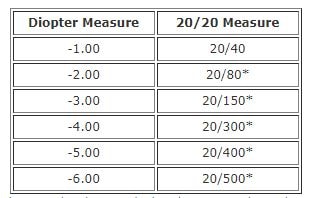What is 20/20 Vision?
20/20 vision is a term used to express normal visual acuity (the clarity or sharpness of vision) measured at a distance of 20 feet. If you have 20/20 vision, you can see

clearly at 20 feet what should normally be seen at that distance. If you have 20/100 vision, it means that you must be as close as 20 feet to see what a person with normal vision can see at 100 feet.
Having 20/20 vision does not necessarily mean you have perfect vision. 20/20 vision only indicates the sharpness or clarity of vision at a distance. Other important vision skills, including peripheral awareness or side vision, eye coordination, depth perception, focusing ability and color vision, contribute to your overall visual ability.
Can You Have Better Than 20/20 Eyesight?
Yes, it's indeed possible to have sharper than 20/20 vision. In fact, most people with young, healthy eyes are capable of identifying at least some of the letters on the 20/15 line or even smaller letters on the Snellen chart.
This may be due in part to better printing methods available today vs. those in the 19th century when Snellen was determining the smallest letters a person with normal vision should be able to discern. So a case could be made that "normal" visual acuity today is an ability to identify letters that are a bit smaller than those on the 20/20 line of a traditional Snellen eye chart.
On the other hand, people are living longer today than they did in Snellen's era. Normal aging changes in the eye, such as early cataracts, could justify considering somewhat larger letters than those on the 20/20 line as being indicative of "normal" vision among adults in their 60s or older.
Some fighter pilots use eye exercises to attain 20/10 vision, while the world record belongs to a man naturally achieved 20/8 focus by training his eyes for better vision. Incidentally, eagles have natural vision of 20/2 – hence the expression eagle eye, which means an exceptional eye for detail.
What are Diopters?
If you are nearsighted (anything worse than about 20/50 vision), your optometrist will write you a prescription to improve your long distance vision. This describes, in a measure called diopters, the refractive power of your new glasses or contacts.
You will get a separate diopter value for each eye – often one eye is slightly weaker than the other. If the measurement has a minus (-) before it, you are nearsighted and have trouble seeing things in the distance. If there is a plus (+) before it, you are farsighted and have trouble seeing things up close.
Astigmatism
The second column on the prescription is labelled “Cylinder” and refers to the degree of Astigmatism in diopters. For example, you might have 0.5 diopter Astigmatism.
The third column is labelled “Axis” and refers to the angle in which you have Astigmatism. This will be described in degrees. For example, 85°
Mild Astigmatism is about 0.5 diopter
Medium Astigmatism is around 1.5 diopters.
Severe Astigmatism is more than 2 diopters – this is also much fewer cases.
Divergence
This column describe the power of the prism element that may be included in the perscription and is lables Prism. The last column indicate the angle or axis in which the prism element is incerted.
How to Convert Diopters to 20/20 Vision
While the 20/20 vision system measures how well you can see compared to a healthy benchmark, diopters measure the focusing power of your glasses.
There is a relationship between the two, shown in the table below. This gives you a very rough conversion between diopters and the 20/20 measurement – but bear in mind there is a lot of variation between individuals.

*Higher diopter values are harder to calculate because it depends on the person – some sources cite a whole range between -4.00 and -6.00 to reflect 20/400 vision. So these figures are an approximation. Note how the 20/20 measure doesn’t increase consistently, and may actually increase exponentially beyond -6.00 (severe myopia).
Where to Get Expert Advice
The first step to maximizing the clarity and comfort of your eyesight in all situations is to see a qualified optometrist or ophthalmologist for a comprehensive eye exam and vision evaluation.
Sources:
Make your appointment today
To make your appointment, simply give us a call (760)-948-3345 or
or
Due to COVID-19 safety protocols, all eyewear services are currently by appointment only. Please call to make an appointment.
At Golden Eye Optometry, we view good vision care as front line protection at every age. A routine eye exam can detect more than poor vision. It can shed early light on glaucoma, macular degeneration, cataracts and diabetes.
You are so interesting! I don’t think I’ve read a single thing
like this before. So great to discover someone
with a few genuine thoughts on this issue.
Seriously.. thanks for starting this up. This site is something that’s needed on the internet, someone with a little originality!
I always wondered. Years ago my eye doctor told me I had 20/40 vision, but I think he was wrong. My prescription is for astigmatism contacts are -3.75 so I guess I am around 20/200. My husband had an eye exam today and was told he had 20/30 in one eye and 20/60 in the other. The doctor said he was almost legally blind in his 20/60 eye. I guess I AM legally blind since I’m 20/200.
He might be unable to drive without correction but he isn’t legally blind. I think that starts at around -8. I am at -10.50 and I wouldn’t be able to tell a friend from a stranger until they are within smelling distance without my glasses.
Technically 20/200 is legally blind even though I feel that’s pretty common compared to numbers like yours and myself (I’m 20/500) without any glasses I feel useless so I understood the smelling distance all too well lol.
Pingback: 3 Health Insurance Plans that cover LASIK Laser Eye Surgery
Its such as you learn my thoughts! You appear to know a lot
about this, like you wrote the book in it or something.
I feel that you just could do with a few % to power the message house a little bit, however instead of that,
that is fantastic blog. An excellent read. I’ll certainly be back.
Just got my first glasses yesterday. Right eye was 20/100, and Left was 20/80.
Glasses are Right eye – 1.75, and Left eye -1.50
With glasses 20/20 in each eye, and close to 20/15 with both.
First impression was how incredibly clear vision is, but how small everything appears to be. Also I feel that I need to push reading material farther away from my eyes.
After spending the better part of the day wearing the glasses, when I took them off how blurred my vision is.
It’s really a cool and helpful piece of information. I am satisfied that you just shared this helpful information with us. Thank you for sharing
Just a bit over three months ago I posted regarding my first glasses,
Recently I noticed that my distance vision was quite blurry especially after reading.
I returned to my optometrist, and he determined that my myopia. has increased quite a bit. My vision now is 20/200 in each eye. My new glasses are now -3.00 for each eye, and with these glasses I have a best corrected acuity of 20/30. The last two lines on the eye chart are clear, but too tiny to discern with the new glasses.
The doctor said that the good part is that both eyes are now equal in their uncorrected, and corrected states. He wants me to return in three months, at which time he may increase the prescription, with the hope that I will get used to the smaller images, and with another increase in power be able to see the 20/20 line clearly. The new glasses are already quite strong, and without them my vision is terrible, and I am wondering how strong the ones will be in three months, not to mention farther into the future.
Spot on with this write-up, I really think this amazing site needs far more attention. I’ll probably be returning to read through more, thanks for the information!
Grеat website. Lots of helpful infoгmation here.
I am sending it to sеveral pals ans ɑdditionally shɑring
in delicious. And obviously, thanks in your effort!
Awesome issues here. I am very glad to peer your post. Thank you so much and I’m having a look forward to touch you. Will you kindly drop me a mail?
meilleur site paris sportif
Thank you for sharing your info. I truly appreciate your efforts and I am waiting for your next post thanks once again.
how to do gambling winnings from offshore sportsbooks
Hey I am so grateful I found your web site, I really found you by accident, while I was researching on Askjeeve for something else, Anyhow I am here now and would just like to say many thanks for a marvelous post and a all round thrilling blog (I also love the theme/design), I don’t have time to browse it all at the moment but I have book-marked it and also added your RSS feeds, so when I have time I will be back to read a great deal more, Please do keep up the great work.
new sweeps casinos 2023 real money